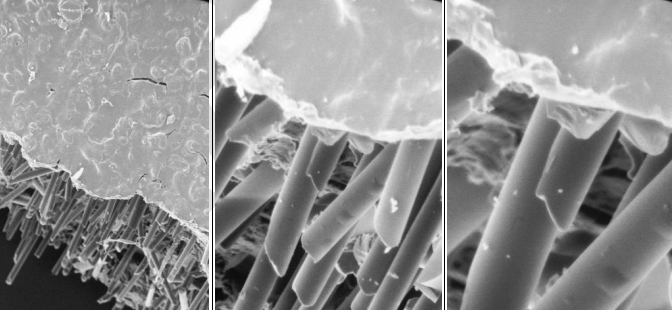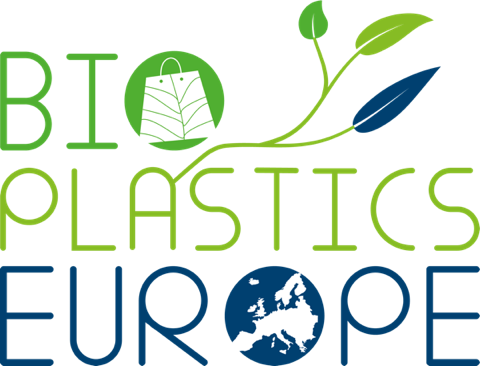Insights from the first round of testing on bio-based biodegradable prototypes
By Elisabetta Arato, Samantha Caputo, and Stefano Gianazzi (Tecnologie Innovative per il Controllo Ambientale e lo Sviluppo Sostenibile (TICASS) Scrl, Italy)

Pictured: Samples examined under a Scanning Electron Microscope (Source: TICASS).
As a co-leader of a 10-partner strong working group, TICASS coordinates the implementation of the experimental activities in the project, towards the next generation of bio-based biodegradable plastics.
The next generation of bio-based biodegradable plastics will have the strength and durability of conventional plastics, but with a more environmentally friendly footprint. To ensure this, the bio-based polymers developed within the BIO-PLASTICS EUROPE project undergo extensive testing, to find and eliminate weaknesses. Five different plastic alternatives were tested over a 15-month period, from September 2020 to December 2021. The selected materials were biodegradable polymers, based on PLA, PBS, and PHBV, that had been matched to different intended applications, such as cutlery, rigid and soft packaging, agricultural mulch films, toys, and fishing materials.
The workflow, defined jointly with the project partners involved, included proper evaluations of the structure, stability, and degradation properties of bio-based biodegradable plastics in both natural environments (i.e., Mediterranean Sea, Northern Sea, limnic water, natural soil) and under specific controlled conditions based on the selected applications. The latter involved, e.g., the study of the effects of aging on bio-based plastics through the weathering of sample materials via a climate chamber, and in light of the diversity of intended applications, the storage of materials inside or in direct contact with the bio-based prototypes (i.e., food, alcoholic beverages and soft-drinks, detergents, etc.) were also mimicked. In addition, biodegradability tests have also been performed, in order to evaluate the possibility of sustainable disposal.
The results showed general low degradability over different environmental conditions and for composting. Only slight decrease of material properties was reported, more evident with temperature increase. Prototypes deployed appeared to be more sensitive to UV-induced aging compared to on-field treatment (soil, seawater and limnic water). Photo-oxidation phenomena could be overcome by adding a light stabilizer additive, allowing UV-resistance, and increasing the shelf-life while ensuring biodegradability. Furthermore, testing in controlled composting conditions and hydrolytic enzyme assay confirmed limited amounts of degradation and low degradation rates.
Environmental impact of bio-based plastics was also studied by means of ecotoxicological tests with different species involved depending on the target environment, such as plants (phytotoxicity), earthworms, Daphnia Magna (limnic invertebrate), algae and marine invertebrate.
The results showed no relevant effect on phytotoxicity. Test on earthworms did not affect mortality rates, but the presence of plastic particles promotes their downward movement and, in some cases, leads to a significant decrease of reproduction ability. No acute toxicity toward algae and marine invertebrate was reported, except in the case of PHBV-based material for toys application. In addition, 2-methylnaphtalene has been detected during leaching test on PLA-based mulch film. The substance is toxic to aquatic organisms and may cause long-term effects in the aquatic environment.
Overall, these results show promising future use of bio-based materials developed in the project as a viable alternative to conventional plastics, due to their chemical and physical resistance. If on one hand, good shelf-life and durability are necessary features to guarantee the quality of the final product, then on the other hand, the degradation undergone by the material during its life is an advantage in its disposal, ensuring easier biodegradation. But finding the right balance between material performance and its sustainability in terms of environmental impact and waste management is quite a challenge! Based on the encouraging results of round I of testing activities, the compounds will be modified to improve biodegradability and reduce eco-toxicity effects, maintaining shelf-life and quality of final products. The “improved” bio-based prototypes will be tested in round II with the aim of developing environmentally friendly and sustainable bio-based biodegradable prototypes which may compete in their versatility with conventional plastics, contributing to the shift towards independence from fossil-based resources. The preliminary results of the final testing round are expected to be announced by the end of 2022.


